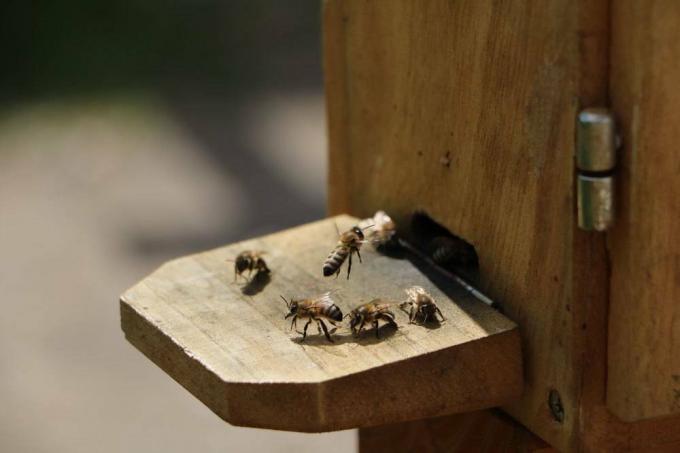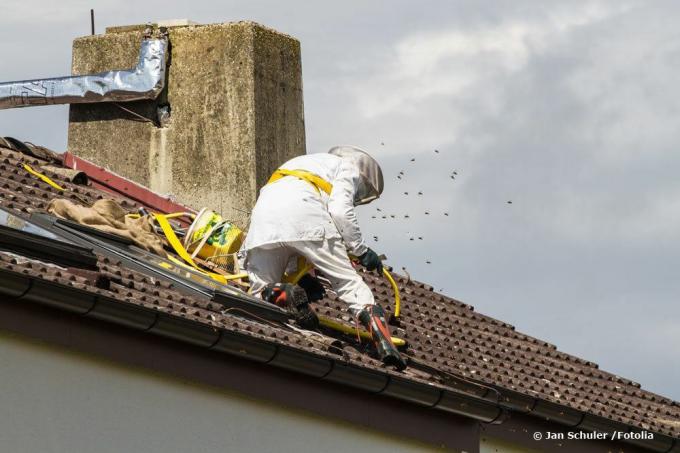
table of contents
- Do bee nests have to be removed?
- Correct handling
- Legal situation
- Removal by the beekeeper
- 1. Contact bee specialist
- 2. costs
- 3. Clean location
- 4. Analyze the bee species
- Relocating bees: instructions
- 1. Location
- 2. suitable materials
- 3. Bird protection
Do you have a beehive in your house, in a roller shutter box or in the garden and are concerned about your safety or that of your children? Bees of different genera and species belong to the culture followers of humans and like to nest in buildings or gardens, as they can build and maintain their nests here undisturbed. In this case, it is necessary to remove the nest if allergy sufferers, sensitive people or small children are at risk.
Do bee nests have to be removed?
Before you start thinking about removing the bee nest, you should think about whether it is even necessary. Bees ask themselves no danger for humans when they are left alone. Bees only sting when they can no longer escape, for example if you accidentally lean on them or try to get into the nest. Over the winter, the insects withdraw to their winter quarters. This means that you only have the bees in close proximity for a period of a few months. If you have no allergy sufferers, small children or sensitive people with you, you can leave the people alone.
Correct handling
The following tips will help you deal with the animals:
- Equip windows with fly screens
- Use home remedies such as lavender oil, basil plants or incense to keep bees away from living spaces
- never hit the animals or threaten the nest
- do not walk barefoot in the grass, as bees are also looking for food and pollen there
- if the nest is not on or in the house, seal it off with tape at a safe distance
- Do not leave sweet food and drinks open
- Explain to children not to get too close to the bees
Bees are pleasant companions and in many cases you can save costs if you consider living with the insects for a short time. In many cases, it is even more worth moving the animals than contacting a professional for removal. You can also use home remedies to get rid of the insects gentle expel. The bees will then look for other possible housing that you can easily provide.

tip: Be sure to check carefully whether the animals are wasps, hornets or bees, as each of the insects must be relocated or removed in a different way. Many people instantly relax when it comes to bees as they generally have a better reputation than wasps or hornets.
Legal situation
Removing a bee nest is a delicate matter, especially in terms of the legal framework, as bees are particularly protected in Germany. Especially wild bees are under natural reserve. Wild bees are all bees that are not tended by a beekeeper and in some cases are used commercially. However, honey bees are also under nature protection, but they will not nestle with you because they are controlled by the beekeeper. Accordingly, the following violations are punishable:
- Catch bees
- Killing bees
- Remove the bee nest without authorization
- Willingly disturb bees
- Damage nests
Bees are due to the Bee deaths protected, as the natural balance is dependent on the insects. The penalty for one of the above-mentioned offenses is a fairly high fine between 50,000 and 60,000 euros. You will not receive a penalty for removing the bee nest from one Professional let take over. Please note, however, that not every bee nest can be removed, especially if it is not in the direct vicinity of humans. Even if the bees in your garden have occupied a tree, the nest may not be able to be removed. The decision rests with the specialist, who includes issues such as allergy sufferers or the proximity to small children in the analysis.
Removal by the beekeeper
The best way to get rid of the bee nest is to have a local beekeeper move it. Bees are extremely important animals, so you should definitely refrain from being destroyed by the exterminator. In many cases this is only allowed with high fees. With beekeepers, however, the costs of relocating a colony are limited, especially when it comes to honeybees that have found a new home as a swarm. When hiring a beekeeper, you need to do the following:
1. Contact bee specialist
Inquire about that responsible beekeeping association Your city or town. These have a register of bee specialists who are eligible for removal. Of course, you can contact well-known beekeepers from whom you have already bought honey, for example, or who lives near you.

2. costs
The reason to contact a beekeeping association is to make a comparison. Many beekeepers relocate the insects for free as this has a positive impact on the environment, which in turn increases the beekeeper's production of honeybees. There are, of course, numerous beekeepers who charge a relocation fee, but the cost is much less compared to removing a wasp's nest. On average, these amount to 50 euros.
3. Clean location
Since beekeepers remove the bees along with the nest, all you have to do is identify the location of the nest clean. This will prevent more bees from nesting with you as they will be attracted to the smell.
4. Analyze the bee species
The beekeeping association can also help you analyze what type of bee it is or whether you are mistaking the honey producers for wasps. The specialist will look at the animals and the nest and decide whether they are honey or wild bees and how best to relocate them.
The great advantage of hiring a beekeeper is the expertise that saves you additional costs. An exterminator is not recommended for this task and can even result in a penalty if you do not announce the destruction of the nest in advance. If the bees are honey bees, you are even helping the beekeepers out, as they can integrate them into their population as another colony. Wild bees are also relocated, even if they are solitary bees. Like all other bee species, these build nests that can be relocated. Home remedies work even better for wild bees.
tip: save yourself the phone call to the fire brigade regarding the furry polish collectors. The fire brigade is not allowed to dissolve the bee nests and is clearly the wrong contact for it.
Relocating bees: instructions
Since a bee's nest cannot simply be removed over the winter like with wasps, there are other options for you to get rid of the nest. Relocating is an easy way to offer the bees a better home than your roller shutter box. In addition, the relocation is cheap in terms of costs and can be easily done by you done by myself will. Relocating yourself is not associated with a penalty and can be implemented even more effectively together with a home remedy to drive the bees away. Note that this type of relocation only works with wild bees, not honey bees. Follow the instructions below to relocate the bee nest:
1. Location
Choose a location for the bee hotel that is in a sunny, sheltered location. The best locations are west, south or east, which should be set up a little further from your house. Bees like it warm and calm when it comes to their housing. Staggering, wobbling or swinging dwellings are avoided. The more undisturbed the place, the better.
2. suitable materials
There are three devices available for relocation:
- stratified interlocking tiles
- hollowed out stems
- Nesting wood made from dried hardwood
These materials make it easy to design bee hotels, as the animals can lay their cocoons in the spaces in between. You can also close the holes yourself. When choosing the nesting wood, however, you should definitely refrain from using coniferous wood, as this is too soft to work with and the bees do not like to accept it.

3. Bird protection
Also, take care of one Bird protection. Blue plastic nets or wire meshes with a mesh size of 3 x 3 centimeters are available for this. Avoid using green plastic nets as they are deadly to birds and hedgehogs.
With these steps, you can easily relocate the wild bees by yourself and not have to remove them with the help of a beekeeper.


